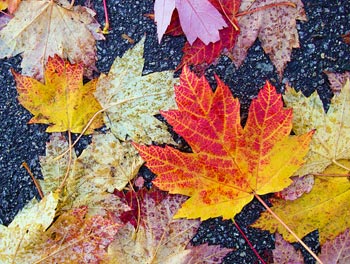Your garden party of fall cleanup tasks
Time is running out for a fall spiff-up. Follow these tips for what to do and not do when cleaning up your garden this fall.
There are things that should get done, things not to do, and personal choice projects. Let’s start the fall garden party now.
Things to do
 Removing leaves from the lawn. As the leaves continue to fall, your lawn is being buried. The lack of light and the trapped moisture can put the grass into a weakened state to survive yet another Michigan winter. Leaves can be mowed and chopped into small enough bits that they can sift past the grass to drop to the ground. It is easier to get dry leaves to shatter into pieces than wet clumps, so it is important to choose your day.
Removing leaves from the lawn. As the leaves continue to fall, your lawn is being buried. The lack of light and the trapped moisture can put the grass into a weakened state to survive yet another Michigan winter. Leaves can be mowed and chopped into small enough bits that they can sift past the grass to drop to the ground. It is easier to get dry leaves to shatter into pieces than wet clumps, so it is important to choose your day.
You can become a “leaf herder.” This involves starting in the middle of the yard and blowing and chopping the leaves in opposite directions with the discharge chute facing the side of the yard. Each time you run over the leaves, they are chopped and re-chopped. The leaf pieces can be blown into beds or borders around trees and shrubs. All those valuable tree leaf nutrients are recycled to the plants below. Since they are chopped, the water will run around the pieces and because they are broken down, the leaves are less likely to be blown out of the beds.
If perennials are completely buried, it will be necessary to rake or broom and knock the leaves off the tops of plants. If you are planning to rake leaves, at least they are now in one nice windrow to push into bags or containers. Since many are already chopped, more can be picked up at one time. Now you have organic matter to turn into the vegetable garden or stockpile for the compost pile and it is free. As the saying goes, cheap is good; free is better.
Removing diseased flower or vegetable garden plants. Remove vegetable garden plants now and either burn them or bury them where they won’t see the light of day for at least a year. In the flower garden, wait until the first hard, killing frost and remove the diseased plant material while it is still limp and does not crumble. This will help with disease control for next season.
Things not to do
Do not prune trees and shrubs. Even if they look a little overgrown, wait until next spring. Pruning involves removing tissue and opening wounds in a plant that still has the winter to contend with. The injuries have no time to heal. There exists a chance that a pruned tree or shrub could have dieback at the site of the injuries caused by severe cold. Pruning also stimulates a tree or shrub to attempt to grow new wood to replace the pruned material if the weather is mild. Any new growth produced in the fall is likely to be killed because it has not had any time to harden off or become woodier. This is not new information; Michigan State University Extension horticulture educators and Master Gardeners have recommended not pruning in the fall for many years.
An optional garden project
Perennial flower bed cleanup. If fall is plant removal time, it is best to do this after the frost has flattened the plants for the year. Tops can be removed or they can be left in place. Seed tops may be food sources for small birds during the winter. The dead stems of the perennials act as snow fences to hold snow in the garden. This helps insulate the crowns of the plants against rapid temperature changes.
Long ago, snow was called “poor man’s mulch” because it didn’t cost anything and helped protect plants in the winter. Grasses and tall sedums can add winter interest when there is little or not much going on. If leaving dead plant tops over the winter, remove them in the spring as soon as you can get outside.
March or April gives eager gardeners a chance to dive in and start the new gardening season. So party on while the weather cooperates.
Photo credit: Kenny Louie, Wikimedia Commons



 Print
Print Email
Email




